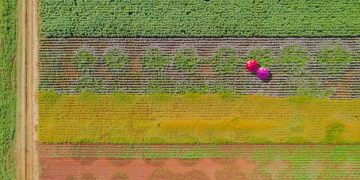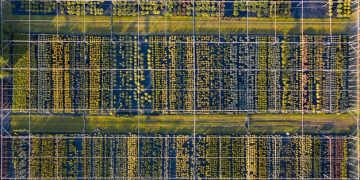Integrated Pest Management: Reduce Pesticide Use by 30% Next Season

Learn how to implement integrated pest management (IPM) strategies to reduce pesticide use by 30% next season by focusing on preventative measures, monitoring, and targeted interventions using biological controls and cultural practices.
Are you looking to reduce your reliance on pesticides and promote a healthier, more sustainable agricultural practice? Learn how to implement integrated pest management strategies to reduce pesticide use by 30% in the next season involves a holistic approach that considers the entire ecosystem and focuses on long-term prevention.
Understanding Integrated Pest Management (IPM)
Integrated Pest Management (IPM) is a comprehensive approach to pest control that minimizes reliance on synthetic pesticides. It’s not about eradicating pests entirely, but managing them to prevent unacceptable damage while protecting the environment and human health.
IPM is a decision-making process that uses multiple tactics to manage pest populations. This approach aims to keep pest numbers low enough to prevent economic damage while also minimizing risks to human health and the environment.
Key Principles of IPM
Several core principles guide IPM strategies, forming the basis for effective and sustainable pest management.
- Prevention: Focus on creating conditions that are unfavorable for pests.
- Monitoring: Regularly inspect crops and the surrounding environment to detect pests early.
- Thresholds: Determine the level of pest infestation that warrants intervention.
- Integrated Tactics: Use a combination of methods, including biological, cultural, and chemical controls.

IPM is not a one-size-fits-all solution. It requires careful planning, monitoring, and adaptación based on specific conditions and pest pressures. By understanding the principles of IPM, farmers can significantly reduce their reliance on pesticides while maintaining healthy and productive crops.
The First Steps: Prevention and Planning
Prevention is the cornerstone of successful integrated pest management (IPM). By proactively creating an environment less conducive to pests, you can significantly reduce the need for reactive control measures.
Effective planning involves understanding the specific pests that target your crops and knowing their life cycles, preferred habitats, and vulnerabilities.
Crop Selection and Rotation
Choosing pest-resistant varieties and implementing crop rotation are powerful preventative measures.
- Select resistant varieties: Opt for crop varieties known to resist common pests in your area.
- Rotate crops: Disrupt pest life cycles by rotating different crops each season.
- Maintain soil health: Healthy soil supports healthy plants, which are naturally more resistant to pests.
Proper planning and preventative measures are the foundation of a successful IPM strategy. By understanding your crops, pests, and environment, you can create a system that minimizes pest problems from the outset.
Monitoring and Identification: Know Your Enemy
Regular monitoring is critical for detecting pest infestations early, before they cause significant damage. Effective monitoring involves carefully inspecting crops for signs of pests or their damage.
Accurate identification is crucial for choosing the right control methods. Not all insects are pests; many are beneficial and contribute to natural pest control.
Scouting Techniques
Various scouting techniques can be used to monitor pest populations effectively.
- Visual inspection: Regularly walk through fields and examine plants for signs of pests.
- Trapping: Use traps to monitor the presence and abundance of specific pests.
- Sampling: Collect samples of plants or insects for closer examination.
By carefully monitoring your crops and accurately identifying pests, you can make informed decisions about when and how to intervene. Early detection and accurate identification are crucial for effective IPM.

Biological Control: Harnessing Nature’s Power
Biological control involves using natural enemies of pests to reduce their populations. This can include predators, parasites, and pathogens that prey on pests.
By creating a favorable environment for beneficial organisms, you can enhance natural pest control and reduce your reliance on pesticides.
Attracting Beneficial Insects
Several strategies can attract and support beneficial insects in your fields.
- Planting diverse flora to provide habitat and food sources.
- Reducing or eliminating pesticide use which protects beneficial insect populations.
- Providing water sources, like shallow dishes of water with pebbles for insects to land on.
Choosing the right biological control agents and creating an environment that supports them should be considered when implementing pest controle strategies. By understanding the complex interactions within your agroecosystem, you can create a more balanced and resilient system that minimizes pest problems.
Cultural Practices: Creating an Unfavorable Environment for Pests
Cultural practices involve modifying farming practices to make the environment less suitable for pests. These practices can disrupt pest life cycles, reduce their ability to thrive, and promote overall plant health.
Effective cultural practices require a deep understanding of pest behavior and the unique characteristics of your crops and environment.
Sanitation and Weed Control
Maintaining clean fields and controlling weeds are two important cultural practices for pest management.
- Remove crop residue where pests can overwinter.
- Control weeds that can serve as alternate hosts for pests.
- Ensure proper drainage to prevent conditions that favor certain pests.
By implementing these cultural practices, you can reduce pest problems and create a healthier environment for your crops. Cultural practices are the foundation of a sustainable IPM strategy.
Selective Pesticide Use: When and How
While the goal of IPM is to minimize pesticide use, there may be times when selective pesticide applications are necessary to prevent economic damage. Using pesticides should always be a last resort, and carefully selected to minimize impacts on beneficial organisms and the environment.
Selective pesticide use requires careful consideration of the specific pest, the crop, the environment, and the potential impacts of the pesticide. Always follow label instructions carefully and take precautions to protect yourself and the environment.
Choosing the Right Pesticide
When pesticide application is necessary, choose the product that is most effective against the target pest while minimizing harm to beneficial organisms.
- Opt for narrow-spectrum pesticides that target specific pests rather than broad-spectrum products.
- Consider using biopesticides, which are derived from natural sources and are generally less harmful to the environment.
- Apply pesticides at the most effective time of day, typically early morning or late evening, when beneficial insects are less active.
By using pesticides judiciously and strategically, you can minimize their negative impacts while still protecting your crops from unacceptable damage. Selective pesticide use is an important tool in the IPM toolbox, but it should be used responsibly and only when necessary.
Evaluating and Adapting Your IPM Strategy
Integrated Pest Management is not a static system; it requires continuous evaluation and adaptation to remain effective. Monitoring your results and adjusting your strategies as needed is essential for long-term success.
Regularly assess the effectiveness of your IPM strategies and be willing to make changes based on your observations and data. IPM is a learning process, and the more you observe and adapt, the more effective your system will become.
Tracking Your Results
Carefully track your pest populations, crop yields, and pesticide use over time to assess the effectiveness of your IPM program.
- Keep detailed records of pest infestations, control measures, and their outcomes.
- Compare your results to previous years or neighboring farms to identify areas for improvement.
- Use data to inform future decisions about crop selection, cultural practices, and pest control methods.
By evaluating and adapting your IPM strategy, you can continuously improve your pest management practices and achieve long-term sustainability. IPM is a journey, not a destination, and ongoing learning and adaptation are essential for success.
| Key Point | Brief Description |
|---|---|
| 🌱 Prevention | Focus on creating unfavorable conditions for pests. |
| 🔍 Monitoring | Regular inspection to detect pests early on. |
| 🐞 Biological Control | Using natural enemies like predators to reduce pest populations. |
| 🚜 Cultural Practices | Modifying farming practices to make the environment less suitable for pests. |
Frequently Asked Questions (FAQ)
▼
IPM is a sustainable approach to pest control that combines multiple strategies to minimize pesticide use and protect the environment. It prioritizes prevention, monitoring, and targeted interventions.
▼
IPM reduces pesticide use, protects beneficial insects, and promotes a healthier ecosystem. It can also lead to cost savings and improved crop quality in the long term.
▼
Monitor pest populations by visually inspecting plants, using traps, and sampling. Keep records of your findings to track pest trends and inform control decisions. Doing this ensures effective, timely interventions.
▼
Biological control includes using predators like ladybugs to control aphids, introducing parasitic wasps to control caterpillars, and applying microbial insecticides to control soil pests.
▼
Use pesticides as a last resort when other IPM strategies are not sufficient to prevent economic damage. Choose selective pesticides and apply them carefully to minimize harm to beneficial organisms.
Conclusion
Implementing integrated pest management strategies is a proactive step toward sustainable agriculture, significantly reducing pesticide use while maintaining crop health and environmental integrity. By embracing prevention, monitoring, and integrated control methods, you can achieve a balanced and resilient agroecosystem that benefits both your crops and the planet.





